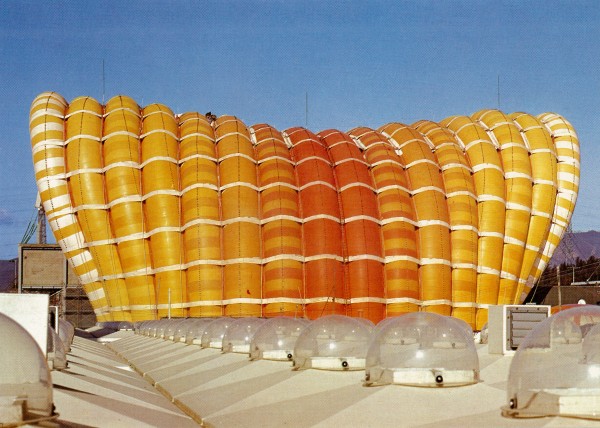A 15-perforation, 70mm film format projected horizontally, with a rolling-loop system, onto very large screens – between six and eight stories in height. IMAX requires specialized camera, projection and sound technologies, and the image is designed to occupy up to a 120-degree lateral view and an 80-degree vertical view.
Film Explorer

Blue Planet (1990). IMAX prints are 70mm wide and run through the projector horizontally, rather than vertically.
Cinémathèque française, Paris, France.
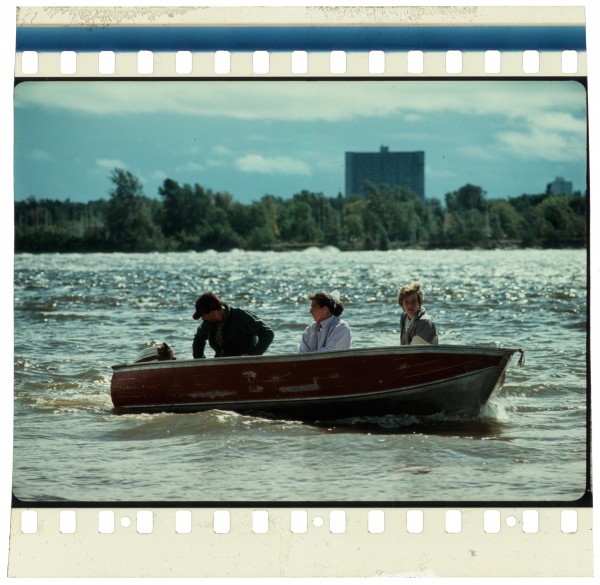
Niagara: Miracles, Myths & Magic (1986). 70mm IMAX prints are mute. The 6- or 8-channel sound is played back from a synchronized digital audio disc.
Cinémathèque française, Paris, France.
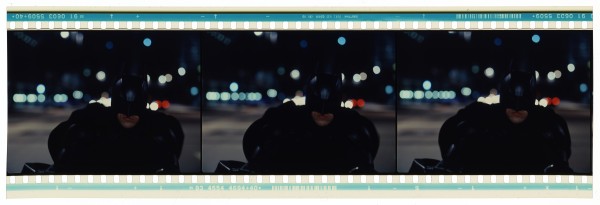
Christian Bale as Batman in The Dark Knight (2008). This is one of several action set-pieces shot with 65mm IMAX cameras. The rest of the film was photographed in 35mm film and processed through DMR (IMAX's proprietary digital remastering tools) for 70mm IMAX release prints. Shifts in aspect ratio indicate the source format. The Dark Knight was the first fiction feature film to be photographed partially in IMAX.
Film Atlas collection, George Eastman Museum, Rochester, NY, United States.
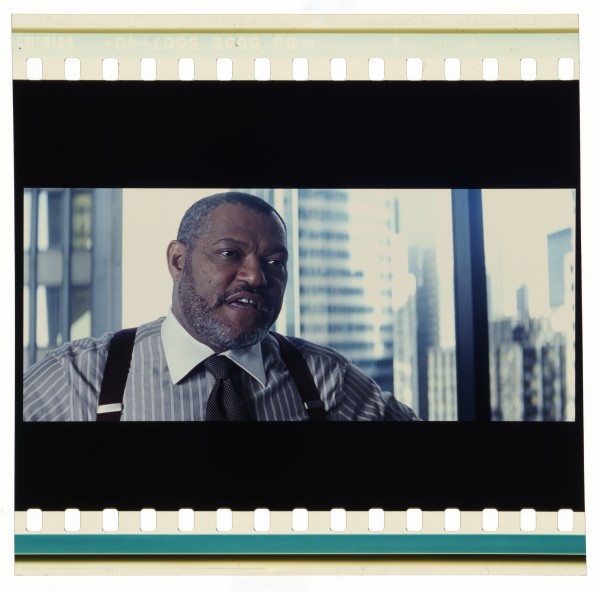
Man of Steel (2013). This is an example of a film shot on 35mm and digitally remastered at 2K resolution through the DMR process for projection on 70mm IMAX film. Note the retention of the 35mm 2.39:1 widescreen aspect ratio through letterboxing.
Identification
69.60mm x 48.51mm (2.74 in x 1.91 in).
1.43:1 in IMAX GT (Grand Theatre) cinemas; 1.8:1 in MPX multiplex facilities. Screen dimensions and ratios may vary at each facility.
Eastmancolor
Standard Eastman Kodak edge markings.
Cellulose triacetate (in some early prints)
1
All IMAX films have been in color, with the exception of Oppenheimer’s combination of color and B/W stocks. IMAX prints made between 1970 and 1982 are likely to have suffered color fading.
IMAX
IMAX sound systems have been continually updated since 1970, with multiple systems in use simultaneously across the theater network:
• 35mm sprocketed magnetic film (1970 onwards)
• 8-track ½ Inch (12.7mm) tape – typically used as a back-up system
• DDP: Digital Disc Playback – compact-disc-based system (introduced c. 1990).
• DTAC: Digital Theatre Audio Control – DVD-based system, including audio for each channel, plus data to reset the sound system for specific films (introduced late-1990s).
70.41mm x 52.63mm (2.772 in x 2.072 in).
Eastmancolor, Fujicolor, B/W (Eastman Double-X 5222) introduced for Oppenheimer (2023).
Standard Eastman Kodak and Fuji edge markings.
History
IMAX is the brand name for a 70mm film format, with 15 perforations per frame (15/70), and its corresponding camera, projection, sound and theatre-design systems. Since the format’s debut in 1970, the IMAX Corporation has established an extensive filmography and a global theatre network. While digital camera and projection systems are now ubiquitous across the movie industry, 15/70 film remains in limited use for film production, and is still exhibited at a small selection of cinemas.
IMAX emerged from converging trends in late-1960s experimental filmmaking, specifically from some custom-format films created for World’s Fairs. At Expo 67, in Montreal, Quebec, Canada, two pavilions featuring immersive multi-image projection and unconventional theatre design provided the technical and artistic foundation for what would evolve to become IMAX. The Labyrinth Pavillion presented a specially made experimental film In the Labyrinth (Dans le labyrinthe), directed by Roman Kroitor, Colin Low and Hugh O’Connor from the National Film Board of Canada – the exhibit had its visitors walk through a series of chambers featuring unconventional configurations of 70mm and 35mm projections. The ‘Man the Explorer’ Pavillion presented Polar Life, directed by Graeme Ferguson and edited by Toni Myers, which offered a multiple-projector, eleven-screen panorama to an audience seated on a rotating platform (CINEMAexpo67, 2017). Planners for the upcoming Expo ’70 in Osaka, Japan, were impressed by the creativity and popularity of these projects and invited their creators to produce a new immersive experience for their planned Fuji pavilion. To take on this project, Ferguson, Kroitor, engineer William Shaw and business partner Robert Kerr formed the Multiscreen Corporation (later renamed IMAX Corp.) and, along with Low (as art director) and director Donald Brittain, grasped the opportunity to not only expand on their existing body of work in experimental documentary, but also to create a new form of film technology to match their artistic vision. The result was the first IMAX film, Tiger Child (1970), where the audience stood on a turntable as they viewed the first 15/70 film projection. This primarily consisted of multi-image compositions shot on regular 70mm and 35mm, with a few full-screen shots captured with a prototype IMAX camera (Feldman, 2014: p. 159).
Expos continued to be central to IMAX’s technical development with successive new systems – including IMAX 3D, Solido, Magic Carpet and IMAX HD – debuting at World’s Fairs throughout the 1980s and 1990s. These events offered large novelty-seeking audiences, generous funding for projects highlighting technical innovation and a rare opportunity for architectural experimentation in theatre design, given the temporary nature of most pavilions. These unique circumstances allowed IMAX’s filmmakers and engineers to experiment with the shape and size of screens, sound-system configurations, seating and audience flow, and technically complex projection systems, in ways that had, historically, been inaccessible to experimental filmmakers.
The World’s first permanent IMAX theatre was opened in 1971 at the Ontario Place Cinesphere in Toronto, Canada. The Cinesphere established the unique geometric properties of subsequent IMAX theatres, with a steeply raked floor, a screen not only wide but also unusually tall, plus the precise directional effects of a six-channel sound system. These features emerged from their inventors’ Expo-based explorations in generating a novel relationship between the audience and the screen, while also prioritizing sensory engagement. The largest-ever IMAX screen, and indeed the largest screen in cinema’s history (demolished in 2016), was constructed in Sydney, Australia, and was 35.7m (117.13 ft) wide and 29.7m (97.44 ft) high. While some filmmakers have used multi-image techniques in IMAX films, particularly when incorporating footage shot in other formats, the refinement of the 15/70 camera system, alongside the sensory possibilities of the unique theatre geometry, ensured that immersive imagery would become an aesthetic priority in the IMAX filmography, and the foundation stone of the format’s brand identity.
During the period from 1971 to 2000, the vast majority of IMAX cinemas were constructed within museums and science centers, as well as at tourist attractions with an educational focus. Consequently, IMAX was initially developed as a documentary medium, which necessarily had an impact on both IMAX filmmaking practice and its technological development. A striking example of this institutional influence is seen with the Smithsonian’s National Air and Space Museum in Washington, DC, whose IMAX cinema has not only sponsored the production of many films about aviation – thereby encouraging advances in aerial IMAX cinematography – but also facilitated collaboration between IMAX and NASA towards the design of IMAX cameras for use in space, the training of astronauts in cinematography, and the documenting of the Space Shuttle program. While this institutional/educational support of IMAX filmmaking came with certain creative restrictions – particularly with regard to dramatic narrative – it did greatly improve the format’s economic viability, since each IMAX film would typically have a far longer run than a standard theatrical release.
In 1994, IMAX was acquired by WGIM Acquisition Corporation, initiating a shift toward commercial filmmaking. Projector systems for multiplexes (IMAX SR and MPX) and a digital remastering system (DMR) for reformatting 35mm feature films were developed. The first DMR IMAX release, in 2002, was a transformed version of Ron Howard’s Apollo 13, whose subject matter made it appropriate for screening at both commercial venues and science museums. Since then, not only have IMAX versions of mainstream films become more commonplace, but IMAX 15/70 production technology has been embraced by dramatic filmmakers. These films typically have variable aspect ratios, with full-frame IMAX sequences alongside those shot in other formats (35mm, 70mm and various digital formats). Notable among these filmmakers is Christopher Nolan, who consistently shoots on IMAX film and prioritizes film (over digital) exhibition.
Selected Filmography
First film to undergo the DMR conversion process, transforming the 35mm original into IMAX format. This version is 20 minutes shorter than the original so that the film could fit on the projection platter.
First film to undergo the DMR conversion process, transforming the 35mm original into IMAX format. This version is 20 minutes shorter than the original so that the film could fit on the projection platter.
First fiction feature film with sequences shot on IMAX film.
First fiction feature film with sequences shot on IMAX film.
First film made using IMAX space cameras.
First film made using IMAX space cameras.
The IMAX camera was modified to minimize weight, so it could be transported on the Everest expedition.
The IMAX camera was modified to minimize weight, so it could be transported on the Everest expedition.
An early example of a film produced both for broad distribution and as a “destination film” for site-specific screenings at the Grand Canyon.
An early example of a film produced both for broad distribution and as a “destination film” for site-specific screenings at the Grand Canyon.
Created for the Canada Pavilion at Expo ’92 in Seville, Spain. First film produced in IMAX HD; filmed and projected at 48 fps.
Created for the Canada Pavilion at Expo ’92 in Seville, Spain. First film produced in IMAX HD; filmed and projected at 48 fps.
Not only includes substantial IMAX footage, but also features an IMAX camera within the story.
Not only includes substantial IMAX footage, but also features an IMAX camera within the story.
Produced for the first permanent IMAX cinema, the Cinesphere at Ontario Place, Toronto.
Produced for the first permanent IMAX cinema, the Cinesphere at Ontario Place, Toronto.
First film to use B/W 65mm film stock for photography.
First film to use B/W 65mm film stock for photography.
The first IMAX film – made for the Fuji Pavilion at Expo ’70 in Osaka, Japan.
The first IMAX film – made for the Fuji Pavilion at Expo ’70 in Osaka, Japan.
Produced for the Smithsonian’s National Air and Space Museum. Arguably the longest-running film in history, with consistent screenings since the museum’s opening in 1976 to the present day.
Produced for the Smithsonian’s National Air and Space Museum. Arguably the longest-running film in history, with consistent screenings since the museum’s opening in 1976 to the present day.
Technology
IMAX film is notable for its high resolution and immersive imagery. It uses 70mm film running sideways, with a frame that is 15 perforations wide.
While both camera and projector equipment have evolved for ease of use, camera mobility and other practical considerations, it is notable that the IMAX format remains fundamentally unchanged since 1970, due to the high level of technical precision and creative experience of its inventors. While digital camera and projection systems are now ubiquitous, IMAX 15/70 film is still used in both production and projection.
Rolling Loop
The rolling loop mechanism is integral to the IMAX system, allowing for smooth frame advancement, minimal wear on prints and a high level of image stability. Australian Ron Jones invented the rolling loop process for use in 35mm projection, whereby the film would advance through an undulation movement, rather than being dragged forward by its sprockets. In the early stages of technical research for Tiger Child, William Shaw consulted with Jones, and would adapt his system for use with 15/70 film. Additional innovations, including pin registration and a quartz glass field flattener, ensure that IMAX projectors are extremely stable – further enhancing image quality. IMAX frames are roughly ten times the size of conventional 35mm and can be projected onto proportionately larger screens.
Cameras
The first IMAX Camera, Camera 1, became the model for the Mark II (MKII), the standard IMAX 2D camera. Subsequent camera systems prioritized factors including reduced weight (MKII LW – lightweight), a reflex shutter (IW5/5A), higher frame rates (IW8 – up to 96 fps), improved low-light cinematography, larger magazines, and vibration control (Douglas, 1994a). The MSM 9802 camera incorporated video output and more advanced electronic components, while also further addressing weight and stability concerns.
Through their collaboration with NASA, IMAX also developed space cameras for operation by astronauts, including a camera built into the Space Shuttle cargo bay. The first IMAX space camera flight was on Challenger mission STS-41C, in April 1984. Design considerations included size restrictions, weightlessness, electromagnetic interference and NASA safety requirements (Douglas, 1994b).
Technical characteristics of cinema design include steeply raked audience seating – between 20 and 25 degrees. IMAX cinemas also require large projection rooms, with a single projector requiring at least 4m (12-ft) square floor space – and weighing at least 1900kg (4189 lb). In many cinemas, particularly in museum settings, the projection booth has a glass rear wall, allowing audiences to view the projection equipment before and after watching the film. In order to expand IMAX in the commercial market, smaller-screen configurations, as well as simplified projector systems were introduced: the IMAX SR (Small Rotor), in 1998; and IMAX MPX, in 2004, intended for retrofitted multiplexes.
The size and weight of IMAX film has historically been a limiting factor to both production and exhibition. Historically, the majority of IMAX films have been around 40 minutes or under in duration, as the platter could originally hold no more than an hour of film. To accommodate commercial feature films, starting with Apollo 13: the IMAX Experience in 2002, IMAX increased the platter size and modified its arms and motors to handle the increase in size and weight. Projection booths are equipped with forklifts to load the individual IMAX reels, which can weigh up to 272kg (600 lb).
Two 48 fps films, branded IMAX HD, were produced: Momentum (1992) for Expo ’92 in Seville, Spain, and Soarin’ Over California (Rick Rothschild, 2001) for the Disney California Adventure theme park attraction. An advantage of the higher frame rate was to minimize strobing effects during fast-paced action.

A comparison of 15/70 IMAX, standard 70mm and 35mm film formats, from an IMAX promotional booklet dating from the 1990s.
Film Atlas collection, George Eastman Museum, Rochester, NY, United States.

65mm IMAX Space Camera, Smithsonian National Air and Space Museum, 2012.
NASA/Paul E. Alers.
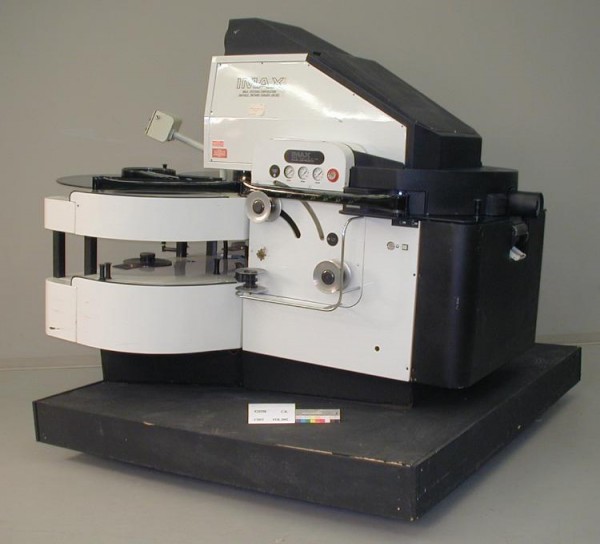
IMAX Projector #3, manufactured by Multiscreen Corp. Ltd. Installed at Circus World in Orlando Florida, in use 1973–92. Ingenium collection 1992.0598.001
1992.0598.001, Ingenium – Canada’s Museums of Science and Innovation, http://collection.ingeniumcanada.org/en/item/1992.0598.001/
References
CINEMAexpo67 (2017). Accessed December 1, 2023. http://cinemaexpo67.ca
Douglas, Althea & Creighton Douglas (1991). Design Considerations for an IMAX Theatre. Toronto, Canada: IMAX Corporation.
Douglas, Creighton (1994a). “IW5/5A Camera”. Creighton Douglas Fonds, Series: IMAX Systems Corporation, "Research and Development Projects", 1985-1994. R12389-183-0-E, Volume number: 9, File 14 . Library and Archives Canada, Gatineau, QC.
Douglas, Creighton (1994b). “Space Shuttle Cameras”. Creighton Douglas Fonds, Series: IMAX Systems Corporation, "Research and Development Projects", 1985-1994. R12389-183-0-E, Volume number: 9, File 14. Library and Archives Canada, Gatineau, QC.
Feldman, Seth (2014). “Tiger Child: IMAX and Donald Brittain Times Nine”. Cinephemera: Archives, Ephemeral Cinema, and New Screen Histories in Canada, pp. 159–83. Montreal & Kingston: McGill-Queens University Press.
IMAX Corporation (1999). IMAX: The 15/70 Filmmaker’s Manual (accessed June 25, 2024). https://kinotechnologies.files.wordpress.com/2011/02/filmmaker1.pdf
Patents
Shaw, William C. Rolling loop film transport mechanism. US patent US3600073A, filed November 24, 1969, and issued August 17, 1970. https://patents.google.com/patent/US3600073A
Shaw, William C. Projection screen assembly. US patent US4406519A, filed February 4, 1982, and issued Septemer 27, 1983. https://patents.google.com/patent/US4406519A
Shaw, William C., Ian Maxwell, Irvine W. Smith. Film deceleration unit. US patent US5050985A, filed October 30, 1990, and issued September 24 1991. https://patents.google.com/patent/US5050985A
Read, Steven Charles, Brian J. Bonnick, George E. Jacques. Conversion of cinema theatre to a super cinema theatre. US patent US7106411B2, filed May 5, 2004, and issued September 12, 2006. https://patents.google.com/patent/US7106411B2
Preceded by
Followed by
Compare
Related entries
Author
Allison Whitney is an Associate Professor of Film and Media Studies in the Department of English at Texas Tech University, Lubbock, TX, United States. Her expertise is in film technology and she is a member of the research team “Locating Transnational Collaborations in the Early History of Imax Films and Architectures (1970–1990)” http://imax-history.ca
Thanks to Tom Everrett, Monika Gagnon, Oliver Husain, James Hyder, Janine Marchessault, Marcia Mordfield, Jessica Mulvogue, Jackson Myers, Christina Stewart, Adele Torrance and Les Whitney.
Whitney, Allison (2024). “IMAX”. In James Layton (ed.), Film Atlas. www.filmatlas.com. Brussels: International Federation of Film Archives / Rochester, NY: George Eastman Museum.
